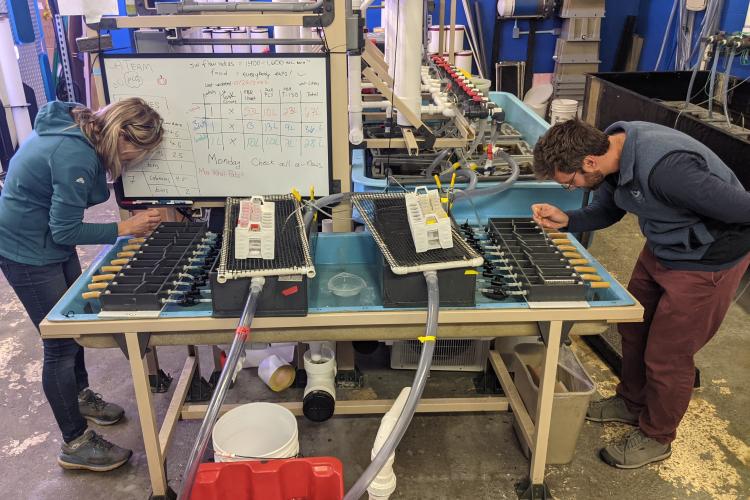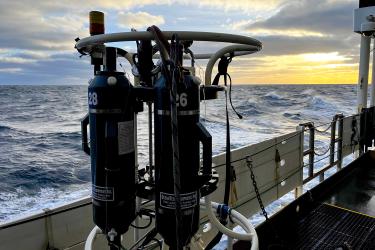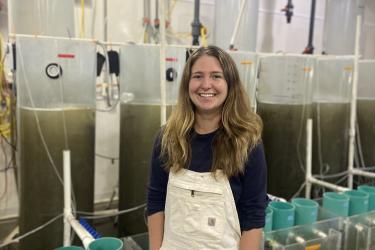Scientists at NOAA Fisheries’ Milford Laboratory in Connecticut, and Fisheries and Oceans Canada’s Pacific Biological Station in British Columbia recently participated in a scientific exchange. It was supported by an Ocean Acidification Collaborative Funding Initiative award to share ocean acidification research methods.
Each laboratory hosted an early-career scientist from the other lab for one week to collaborate and learn methods to examine the effects of ocean acidification on marine invertebrates. The exchange ensures that both research teams can reproduce experimental conditions and measure how shellfish respond to change.
Milford Lab Hosts Canadian Researcher
Chen Walker, a research technician at Canada’s Pacific Biological Station, traveled to Milford, Connecticut. She assisted our research group with an ongoing experiment on the effects of ocean acidification on bay scallops. She also learned about our lab’s seawater systems and the methods we use to measure shellfish physiology.
“The Milford Lab is able to measure many ways that shellfish with two shells—scientists call them bivalves—respond to ocean acidification. Their team can answer a variety of questions such as at what rate do bivalves respire, release waste, and eat algae? And do their blood cells respond?” explained Walker. “Using these methods they estimate how bivalves like scallops respond to change throughout their lives, and how this affects their growth.”
Walker continued, “The Milford team taught me their methods, so that I may incorporate them back at the Pacific Biological Station. I am grateful to Sam Gurr and everyone at the Milford Lab and hope to continue to collaborate on ocean acidification research.”
Traveling to the Pacific Biological Station
Next, I traveled to the Pacific Biological Station in Nanaimo, British Columbia, Canada. There I participated in an ongoing heatwave and ocean acidification experiment on Pacific oysters.
Marine heatwaves are periods of persistently high seawater temperatures that can affect marine life and coastal communities. The experiment focuses on how Pacific oysters respond to short but frequent periods of warm temperatures and ocean acidification. Similar to our lab, their researchers are interested in how these experimental conditions may affect oyster respiration rates, growth, and gene expression.
The Canadian research team is also interested in how single and back-to-back periods of environmental stress may affect the oysters’ ability to recover. In other words, does a short low-pH event directly following a heatwave event have a greater effect on oysters? This experiment is part of a wider Fisheries and Oceans Canada project examining climate change effects on Pacific oysters and razor clams.
I learned about the research station’s automated seawater system and the molecular methods they are using in this study. The research station houses Fisheries and Oceans Canada’s Climate Change and Ocean Acidification Laboratory, an incredible wet lab equipped for ocean acidification experiments. Programmable sensors allow automated control of partial pressure carbon dioxide to mimic ocean acidification conditions. Their system can also control seawater temperature, seawater flow, salinity, and dissolved oxygen. Together, this allows researchers to simulate upwelling and warming events, heatwaves, hypoxia, and more! Their lab is a unique space that offers extensive possibilities for applied research.
I look forward to a productive future of collaborative science between the United States and Canada to understand the effects of ocean acidification. With our newly standardized methods, we can now build comparable datasets across species and coasts. We plan to continue discussions about high-priority areas of mutual concern and opportunities to support more research projects together!







